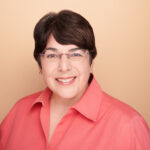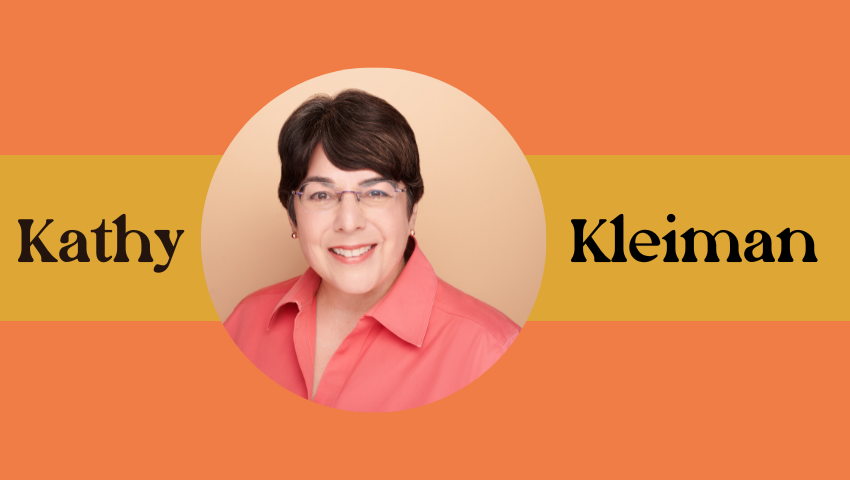Headshot courtesy of Kathy Kleiman
For the 50th conference, SIGGRAPH 2023 welcomes author, lawyer, professor, and storyteller Kathy Kleiman to the stage as a keynote speaker. In her presentation “Computer Programming Pioneers Revealed,” Kleiman will take SIGGRAPH participants back to the 1940s and share the untold story of the six women who programmed the ENIAC, the “Electronic Numerical Integrator and Computer,” and the world’s first general-purpose, programmable, all-electronic computer and a secret U.S. Army project during World War II. Before you hear this fascinating piece of computer history from Kleiman at SIGGRAPH 2023, go beyond the bio and get to know how she put the spotlight on this story and how it can inspire the next 50 years of computer graphics and interactive techniques.
SIGGRAPH: SIGGRAPH 2023 is thrilled to welcome you as a Keynote Speaker this year. The research and work you’ve done to uncover and tell the stories of the ENIAC women programming pioneers is fascinating and trailblazing. What about ENIAC and the pioneer programmers first interested you?
Kathy Kleiman (KK): I am thrilled be attending SIGGRAPH 2023! What first interested me about the ENIAC were the black-and-white photographs of young men and women in the 1940s — photos highlighting an eight-foot-tall, 80-foot-long black steel computer — but only the names of the men were in the captions. I wanted to know the names of the women. That took a long time, and when I found out the women were the ENIAC Programmers, and that all six of the original programmers were young women, I was hooked and wanted to learn more!
For decades, the history of ENIAC had been written as a history of hardware and the brilliant men who built it. It took five decades to uncover that an equally brilliant group of young women programmed it and lay the foundation for modern programming and software. Their story fascinated me.
SIGGRAPH: This passion led you to founding the ENIAC Programmers Project, producing the award-winning documentary “The Computers,” and authoring the book “Proving Ground: The Untold Story of the Six Women Who Programmed the World’s First Modern Computer” (which releases in paperback on 25 July). How did you go about developing and launching these incredible initiatives?
KK: The ENIAC Programmers Project is a nonprofit that we dedicated to researching, recording, and sharing the story of the ENIAC Programmers. Initially, after I found the ENIAC Programmers, my goal was to record these women telling their stories — oral histories of their World War II work. These stories were so dramatic that we made a documentary, “The Computers: The Remarkable Story of the ENIAC Programmers,” to share them. It is a 20-minute documentary short that premiered at the Seattle International Film Festival in 2014 and won the best documentary short from the United Nations Association Film Festival in 2016. Now with subtitles in Spanish and Portuguese, the documentary has been shown around the U.S. and the world.
Unfortunately, some computer historians still deny the tremendous work of the ENIAC Programmers. Because of that, I recently wrote the book “Proving Ground: The Untold Story of the Six Women who Programmed the World’s First Modern Computer,” published just last summer, to tell this incredible story of the ENIAC Programmers and their contributions to World War II and computing history.
SIGGRAPH: Did you have any specific problems in telling this story?
KK: [Laughs] Yes, many problems. Initially, the women’s contributions were denied. But even later, when I found them and talked to them, initially,it seemed hard for them to remember certain details. Then it occurred to me I might be asking the wrong questions. Just as terminology in graphics has changed over the years, terminology has changed in programming. While many parts of breaking down a human problem for a program are similar, how we interface and communicate with the computer is very different. Since the ENIAC Programmers worked on a computer that had no programming languages (they did not yet exist!), they interfaced directly with the ENIAC’s units — a process called “direct programming.” I spent six months in the Library of Congress reading books about 1940s and 1950s technology, and basically learned how to program the ENIAC (not well, but I did learn). Then I went back to the ENIAC Programmers with questions in their own terminology, and this time they lit up. Of course they remembered, and they started telling stories of what they were doing in their young 20s. Programming the ENIAC was one of the most exciting moments in their lives, and they remembered it in great detail. I was amazed.
SIGGRAPH: What surprised you most about the Programmers’ stories in the process? What responses have you received from the computer graphics and tech communities — especially the women and men of these communities?
KK: What surprised me most is how many people relate to the ENIAC Programmers’ story. Everyone seems fascinated that the first teams in computing consisted of women and men. For many people, the story holds special meaning as they try to assemble strong and diverse tech teams today.
I’m also surprised that I get emails and letters from men who have been in computing for many years. They say they like the story and are surprised they didn’t know about it before. I should add that the response of girls, young women, and older women is overwhelming. The story inspires cheers, and it inspires tears, because while women continue to make strides in computing, they still face many barriers to success. The challenges are hard, and as the ENIAC Programmers inspired me, they seem to be inspiring women and men today.
SIGGRAPH: SIGGRAPH 2023 is celebrating its 50th conference. Is there a key lesson the computer graphics community can learn from the ENIAC programmers and take with them into the next half century of innovation?
KK: Like the story of the ENIAC Programmers, some early teams of computer graphics included women and men. What can we learn from all of them as we look forward to the next half century of innovation? I think the key lesson is that putting the best people on a team with the most diverse perspectives provides the greatest innovation and creativity.
SIGGRAPH: What do you hope the story of the women in front of ENIAC inspires in SIGGRAPH 2023 participants?
KK: I hope SIGGRAPH participants will be inspired in this 50th year to share their own stories and to tell the stories of their teams. It is a wonderful way to welcome young women and young men into the field of computer graphics and to share your passion and excitement with the next generation. Let’s use history to inspire the future! I also hope that everyone at SIGGRAPH will find someone to mentor and bring them further into this incredible community.
Don’t miss Kathy Kleiman’s keynote presentation, “Computer Programming Pioneers Revealed,” taking place Tuesday, 8 August, at SIGGRAPH 2023 in Los Angeles. Register now, and keep an eye out for Kleiman’s book, “Proving Ground: The Untold Story of the Six Women Who Programmed the World’s First Modern Computer,” released in hardcover in 2022 and coming out in paperback on 25 July 2023. Copies will be available at SIGGRAPH 2023.

Kathryn (Kathy) Kleiman is an author, lawyer, professor, and storyteller. Her passion for discovering the truth about the women programming pioneers of ENIAC led her to founding the ENIAC Programmers Project, producing the award-winning documentary “The Computers,” and authoring the book “Proving Ground: The Untold Story of the Six Women Who Programmed the World’s First Modern Computer,” published in July 2022. These accomplishments speak to Kleiman’s passion of inspiring young women and men to pursue careers in computing.
Kleiman, a recognized leader in Internet policy and governance, is a senior fellow with the Tech, Law & Security Program and the Program for Information Justice and Intellectual Property of American University Washington College of Law (AUWCL). She is part of the group that founded the Internet Corporation for Assigned Names and Numbers (ICANN) that oversees and manages the global Domain Name System, and a co-founder of its Noncommercial Users Constituency. She received her bachelor’s degree at Harvard University and her J.D. at Boston University School of Law.



